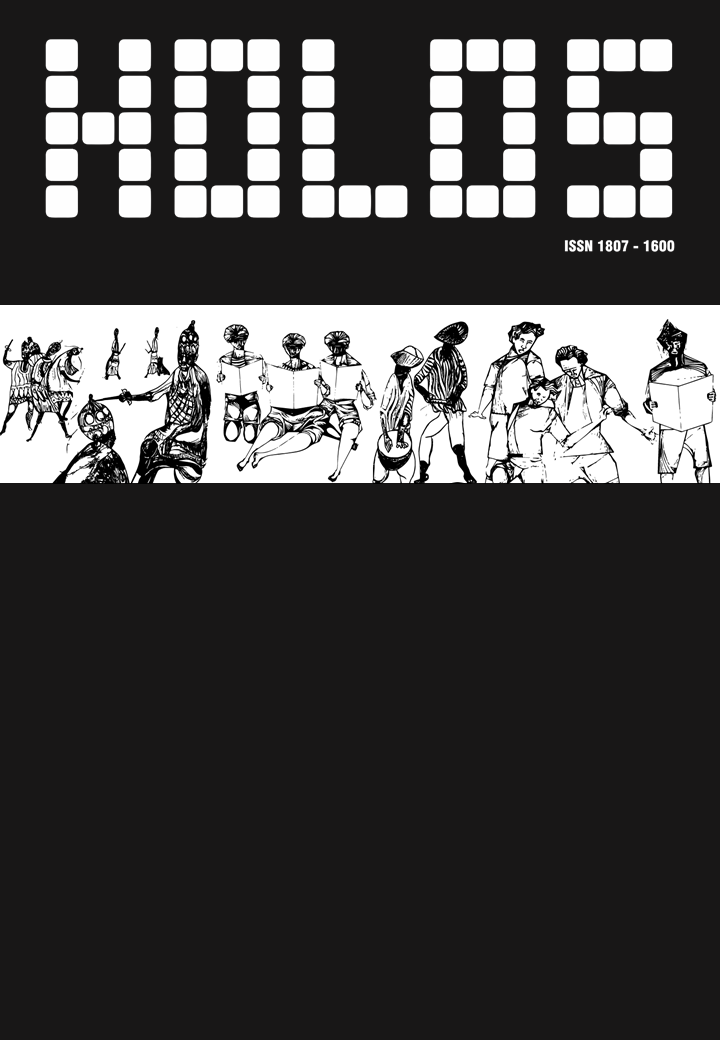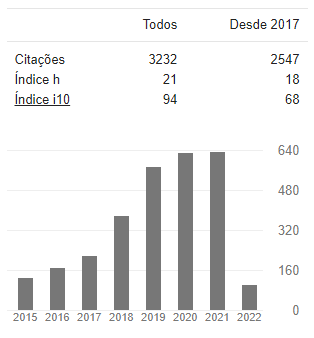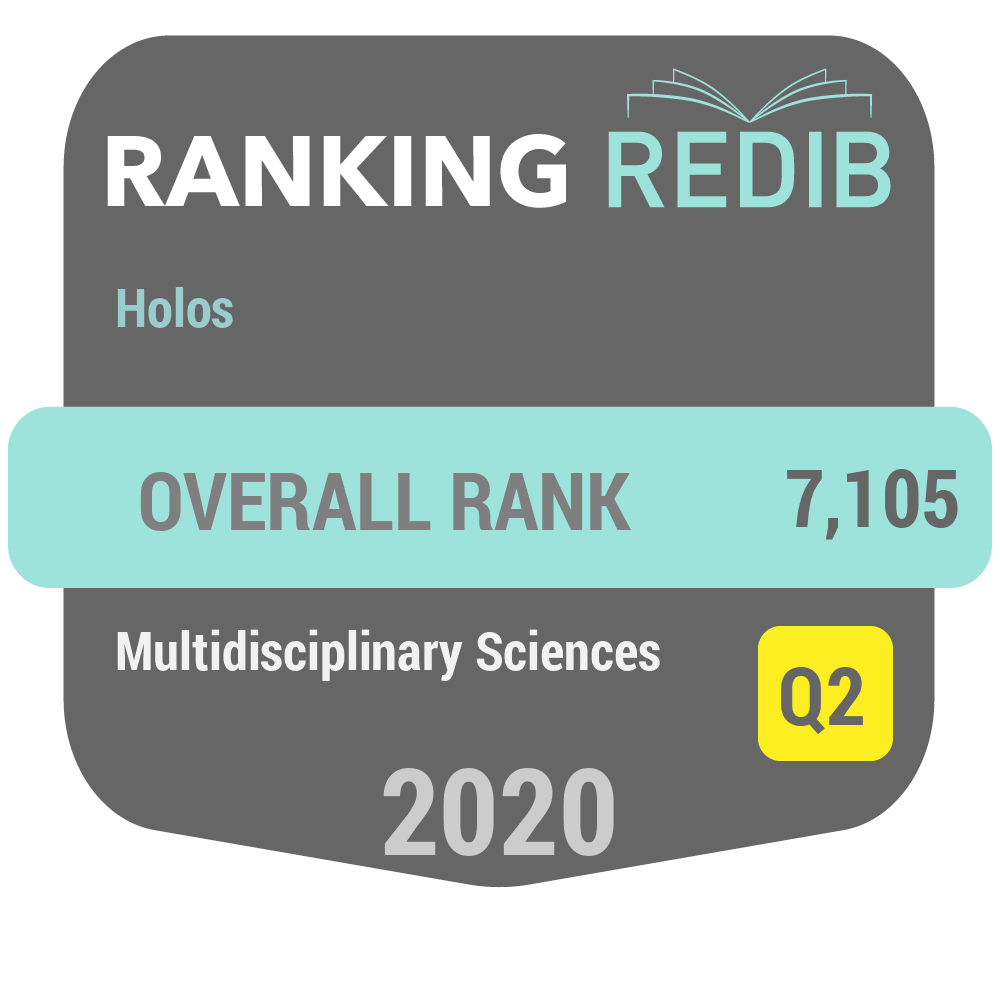Estratégias verbais e visuais para representar o bullying.
UM ESTUDO SISTÊMICO-FUNCIONAL E MULTIMODAL
DOI:
https://doi.org/10.15628/holos.2025.18425Palavras-chave:
Bullying, Anthony Browne, Livros ilustrados, multimodalidade, estereótipos de papéis de gêneroResumo
O artigo examinou a apresentação do bullying nos livros Willy the Chimp, de Anthony Browne. As crianças que estão sofrendo bullying são aconselhadas pela maioria dos protocolos antibullying a contar a alguém, de preferência um adulto (um professor ou um membro da família), então seria de se esperar que essa solução fosse refletida nesses livros. Esses livros são comumente recomendados como leituras antibullying, e queremos analisar como a família e os parentes são apresentados nos textos e ilustrações desses livros. Uma leitura atenta foi realizada desses livros, e atenção especial foi dada a como Anthony Browne apresenta o gênero de Willy em termos de fatores físicos, interesse pessoal e outros critérios. Há um papel de gênero hipomasculino na caracterização de Willy e seu retrato parece ser o fator de risco do bullying.
Downloads
Referências
Adams, H. (2016). The Representation of Gender in British and German Children's Literature after 1950: A Comparative Study of Six Selected Children's Books. In A Dissertation Submitted in Partial Fulfilment of the Degree of MA in Comparative Literature and Cultural Studies. University of Limerick.
Agosto, D. E. (1999). One and Inseparable: Interdependent Storytelling in Picture Storybooks. Children’s Literature in Education, 30 (40), 267-280. DOI: https://doi.org/10.1023/A:1022471922077
Andrieux, B. (1999). De l’homme au singe: l’evolution d’Anthony Browne. La Revue des libres pour enfants, 185, 29-33.
Ansary, N. S., Elias, M. J., Greene, M. B. and Green, S. (2015). Guidance for schools selecting antibullying approaches: Translating evidence-based strategies to contemporary implementation realities. Educational Researches, 44 (1), 27-36. DOI: https://doi.org/10.3102/0013189X14567534
Arizpe, E. (2010). All this book is about books’: Picturebooks, Culture and Metaliterary Awareness. In Colomer, T., Kümmerling-Meibauer, B. & Silva-Díaz, C. (Eds), New directions in Picturebook Research (pp. 69-82). London: Routledge.
Beane, A. L. (2005). The bully free classroom: Over 100 tips and strategies for teachers K-8. Minneapolis, MN: Free Spirit.
Bradford, C. (1998). Playing with Father: Anthony Browne’s Picture Books and the Masculine. Children’s Literature in Education, 29 (2): 79-96. DOI: https://doi.org/10.1023/A:1022407025112
Browne, A. (1984). Gorilla. New York: Alfred A. Knopf.
Browne, A. (1984). Willy the Wimp. New York: Knopf Books for Young Readers.
Browne, A. (1985). Willy the Champ. New York: Random House Children Books.
Browne, A. (1991). Willy and Hugh. New York: Alfred a Knopf Inc.
Browne, A. (1992). Zoo. London: Julia MacRae Books.
Browne, A. (1995). Willy the Wizard. London: Jonathan Cape.
Browne, A. (1997). Willy the Dreamer. London: Walker Books.
Browne, A. (2000). Willy’s pictures. London: Walker Books.
Browne, A. (2015). Willy’s stories. London: Walker Books.
Browne, A. (2016). Willy and the cloud. London: Walker Books.
Cali, D. and Bougaeva, S. (2016). Abigail the Whale. Toronto: Owlkids books.
Campbell, M. A. (2003). Prevention and Intervention for Anxiety Disorders in Children and Adolescents: A Whole School Approach. Australian Journal of Guidance and Counselling, 13(1), 47-62. DOI: https://doi.org/10.1017/S1037291100004738
Campbell, M. A. (2007). Don't worry: Promoting resilience through the use of books in the classroom. Primary and Middle Years Educator, 5(1), 3- 8.
Cañamares, C. (2006). “Modelos de relato para primeros lectores”. M.A. Thesis, Universidad de Castilla-La Mancha (Spain).
Cañamares, C. and Navarro, R. (2015). Selección de lecturas para la prevención del acoso escolar (bullying). Anuario de investigación en Literatura Infantil y Juvenil 13, 39-54.
Chinn, C. A., Anderson, R. C., and Waggoner, M. A. (2001). Patterns of discourse in two kinds of literature discussion. Reading Research Quarterly, 56, 378-411. DOI: https://doi.org/10.1598/RRQ.36.4.3
Coyne, S. M., Linder, J. Ruh, Rasmussen, E. E., Nelson, D. A. and Collier, K. M. (2014). It’s a bird! It’s a plane! It’s gender stereotype!: Longitudinal associations between superhero viewing and gender stereotyped play. Sex Roles 70, 416-430. DOI: https://doi.org/10.1007/s11199-014-0374-8
Craig, W. M. (1998). The Relationship among Bullying, Victimization, Depression, Anxiety, and Aggression in Elementary School Children. Personality and Individual Differences 24, 123–130. DOI: https://doi.org/10.1016/S0191-8869(97)00145-1
Díaz, J. (2008). La imagen en pugna con la palabra. Saber e educar, 13, 43-57.
Doonan, J. (1986). The Object Lesson: Picture Books of Anthony Browne. Word and Image, 2 (2), 159-172. DOI: https://doi.org/10.1080/02666286.1986.10435599
Doonan, J. (1999). Drawing Out Ideas: A Second Decade of the Work of Anthony Browne. The Lion and The Unicorn, 23, 30-56. DOI: https://doi.org/10.1353/uni.1999.0006
DuRant, R. H., Kreiter, S., Sinal, S. H. and Woods, C. R. (1999). Weapon Carrying on School Property among Middle School Students. Archives of Pediatrics and Adolescent Medicine, 153, 21–26. DOI: https://doi.org/10.1001/archpedi.153.1.21
DuRant, R. H., Altman, D., Wolfson, M., Barkin, S., Kreiter, S. and Krowchuk, D. (2000). Exposure to Violence and Victimization, Depression, Substance Abuse, and the Use of Violence by Young Adolescence. Journal of Pediatrics, 137, 707–713. DOI: https://doi.org/10.1067/mpd.2000.109146
Flanagan, K. S., Vanden Hoek, K. K., Shelton, A., Kelly, S. L., Morrison, C. M. and Young, A. M. (2013). Coping with bullying: What answers does children’s literature provide? School Psychology International, 34(6), 691-706. DOI: https://doi.org/10.1177/0143034313479691
Freeman, G. G. (2010). Picture books to develop strategies for dealing with bullying situations: A resource list created by and for young children. Reading Matters 11, 6–11.
Freeman, G. G. (2014). The Implementation of Character Education and Children’s Literature to Teach Bullying Characteristics and Prevention Strategies to Preschool Children: An Action Research Project. Early Childhood Education Journal, 42 (5), 305-316. DOI: https://doi.org/10.1007/s10643-013-0614-5
Gerard, J. M. (1991). The Teasing Syndrome in Facially Deformed Children. Australia and New Zealand Journal of Family Therapy 12, 147–154. DOI: https://doi.org/10.1002/j.1467-8438.1991.tb00863.x
Halliday, M. A. K. (2004 /1985). An Introduction to Functional Grammar. London: Edward Arnold.
Halliday, M A. K., and Matthiessen, C. M. I. (2004). An Introduction to Functional Grammar. London: Routledge.
Hawker, D. and Boulton, M. J. (2000). Twenty Years of Research on Peer Victimization and Psychosocial Maladjustment: A Meta-analytic Review of Cross-sectional Studies. Journal of Child Psychology and Psychiatry, 41, 441–455. DOI: https://doi.org/10.1111/1469-7610.00629
Henkes, K. (1991). Chrysanthemum. New York: Scholastic.
Henkin, R. (2005). Confronting bullying: Literacy as a tool for character education. Portsmouth, NH: Heinemann.
Jalongo, M. R. (2004). Young children and picture books. Washington, DC: National Association for the Education of Young Children.
Juvonen, J. and Graham, S. (2014). Bullying in schools: The power of bullies and the plight of victims. Annual Review of Psychology, 65, 159–185. DOI: https://doi.org/10.1146/annurev-psych-010213-115030
Kaltiala-Heino, R., Rimpela, M., Marttunen, M., Rimpelä, A., and Rantanen, P. (1999). Bullying, Depression, and Suicidal Ideation in Finnish Adolescents: School survey. British Medical Journal, 319, 348–351. DOI: https://doi.org/10.1136/bmj.319.7206.348
Kaltiala-Heino, R., Rimpela, M., Rantanen, P., and Rimpela, A. (2000). Bullying at School. An Indicator of Adolescents at Risk for Mental Disorders. Journal of Adolescence, 23, 661–674. DOI: https://doi.org/10.1006/jado.2000.0351
Klibanski, M. (2006). El origen de una especie. Los libros álbum de Anthony Browne. CLIJ, 190, 7-14.
Kortenhaus, C. M. and Demarest, J. (1993). Gender role stereotyping in children’s literature: An update. Sex Roles, 28, 219-232. DOI: https://doi.org/10.1007/BF00299282
Kress, G. and van Leeuwen, T. (2006/1996). Reading images. The Grammar of visual design. London: Routledge. DOI: https://doi.org/10.4324/9780203619728
Kreidler, W. J. (1996). Smart ways to handle kids who pick on others. Instructor, 106, 70–77.
Laminack, L. L. and Wadsworth, R. M. (2012). Bullying hurts: Teaching kindness through read alouds and guided conversations. Portsmouth, NH: Heinemann.
Lewis, D. (2001). Reading contemporary Picturebooks: Picturing text. New York: Routledge.
McNamara, B. E., and McNamara, F. J. (1997). Keys to dealing with bullies. New York: Barron’s Educational Series.
Moebius, W. (1986). Introduction to Picturebooks Codes. Word and Image, 2, 141-158. DOI: https://doi.org/10.1080/02666286.1986.10435598
Moya, A. J. (2014). A Multimodal Analysis of Picture Books for Children. A Systemic Functional Approach. London: Equinox.
Moya, A. J. (2015). Visual Metonymy in Children’s Picture Books. In M. J. Pinar (Ed.), Multimodality and Cognitive Linguistics (pp. 115-130). London and New York: John Benjamins. DOI: https://doi.org/10.1075/bct.78.08moy
Moya, A. J. (2016a). The role of semiotic Metaphor in the Verbal-Visual Interplay of Three Children’s Picture Books. A Multisemiotic Systemic-Functional Approach. Atlantis, 38(1), 35-52.
Moya, A. J. (2016b). Un modelo teórico para analizar las estrategias interpersonales utilizadas por autores e ilustradores del libro álbum infantil. Una propuesta sistémico-funcional y multimodal. Boletín Hispánico Helvético, 28, 147-173.
Moya, A. J. (2017). Processing Reality in Picture Books. A Multimodal Systemic Functional and Cognitive Study. In Stella Neumann et al. (Ed.), Challenging Boundaries in Linguistics. Systemic Functional Linguistics. Aachen British and American Studies (pp. 431-459). Berlin: Peter Lang.
Moya, A. J. and Pinar, M. J. (2007). La interacción texto / imagen en el cuento ilustrado. Un análisis multimodal. Ocnos, 3, 21-38. DOI: https://doi.org/10.18239/ocnos_2007.03.02
Neumark-Sztainer, D., Story, M. and Faibisch, L. (1998). Perceived Stigmatization among Overweight African-American and Caucasian Adolescent Girls. Journal of Adolescent Health, 23, 264–270. DOI: https://doi.org/10.1016/S1054-139X(98)00044-5
Nikolajeva, M. (1988). Exit Children’s Literature? The Lion and the Unicorn, 22 (2), 221-236. DOI: https://doi.org/10.1353/uni.1998.0028
Nikolajeva, M. and Scott, C. (2001). How Picturebooks Work. New York: Garland Publishing.
Nodelman, P. (1988). Words about pictures. The narrative art of children’s picture books. Athens & London: The University of Georgia Press. DOI: https://doi.org/10.1353/book26685
Nodelman, P. (1991). The Eye and the I: Identification and First-Persona Narratives in Picture Books. Children’s Literature, 19, 1-30. DOI: https://doi.org/10.1353/chl.0.0494
Norton, D. E. (2011). Through the eyes of a child: An introduction to children’s literature. Boston: Pearson.
Olweus, D. (1994). Bullying at School: Basic Facts and Effects of a School Based Intervention Program. Journal of Child Psychology and Psychiatry, 35, 1171–1190. DOI: https://doi.org/10.1111/j.1469-7610.1994.tb01229.x
Oppliger, P. A. and Davis, A. (2016). Portrayals of Bullying: A Content Analysis of Picture Books for Preschoolers. Early Childhood Education Journal, 44 (5): 515-526. DOI: https://doi.org/10.1007/s10643-015-0734-1
Painter, C., Martin, J.R. and Unsworth, L. (2013). Reading Visual Narratives. Image Analysis of Children’s Picture Books. UK: Equinox.
Perrot, J. (2000). An English Promenade. Bookbird, 38 (3), 11–16.
Reidy, D. E., Sloan, C. A. & Zeichner, A. (2009). Gender role conformity and aggression: influence of perpetrator and victim conformity on direct physical aggression in women. Personality and individual differences, 46 (2), 231-235. DOI: https://doi.org/10.1016/j.paid.2008.10.008
Rickert, V. I., Hassed, S. J., Hendon, A. E., and Cunniff, C. (1996). The Effects of Peer Ridicule on Depression and Self-image among Adolescent Females with Turner Sindrome. Journal of Adolescent Health, 19, 34–38. DOI: https://doi.org/10.1016/1054-139X(95)00225-H
Ross, D. M. (1996). Childhood bullying and teasing: What school personnel, other professionals, and parents can do. Alexandria, VA: American Counseling Association.
Salmon, G., James, A., and Smith, D. M. (1998). Bullying in Schools: Self-reported Anxiety, Depression, and Self Esteem in Secondary School Children. British Medical Journal, 317, 924–925. DOI: https://doi.org/10.1136/bmj.317.7163.924
Shavit, Z. (1986). The Ambivalent Status of Texts. In Poetics of Children’s Literature. (pp. 63-92). Georgia: University Press of Georgia.
Shavit, Z. (1999). The Double Attribution of Texts for Children and How it Affects Writing for Children. In S. L. Beckett (Ed.), Transcending Boundaries. Writing for a Dual Audience of Children and Adults (pp. 83-97). New York and London: Garland Publishing.
Singh, M. (1998). Gender Issues in Children’s Literature. ERIC Clearinghouse on Reading, English and Communication Digest 135. (EDO-CS-98-08, noviembre 1998). Accessed November, 14, 2018 from https://files.eric.ed.gov/fulltext/ED424591.pdf/.
Sipe, L. R. (1998). How Picture Books Work: A Semiotically Framed Theory of Text-Picture Relationships. Children’s Literature in Education, 29(2), 97-108. DOI: https://doi.org/10.1023/A:1022459009182
Stephens, J. (1992). Language and Ideology in Children’s Fiction. Harlow: Longman.
Sweeting, H and West, P. (2001). “Being different”: Correlates of the Experience of Teasing and Bullying at age 11. Research Papers in Education, 16, 225–246. DOI: https://doi.org/10.1080/02671520110058679
Unsworth, L. (2006). Towards a Metalanguage for Multiliteracies Education: Describing the Meaning-Making Resources of Language-Image interaction. English Teaching, Practique and Critique, 5 (1), 55-76.
Unsworth, L. (2007). Image /text Relations and Intersemiosis: Towards Multimodal Text Description for Multiliteracies Education. In Leila Barbara and Tony Berber Sardinha (Eds.), Proceedings of the 33rd International Systemic Functional Congress (pp. 1165-1205) São Paulo, Brazil: PUCSP.
Van del Linden, S. (2015). Álbum [es]. Barcelona: Ekaré.
Vlachou, M. , Andreou, E., Botsoglou, K. and Didaskalou, E. (2011). Bully/victim problems among preschool children: A review of current research evidence. Educational Psychology Review, 23(3), 329–358. DOI: https://doi.org/10.1007/s10648-011-9153-z
Vossekuil, B., Reddy, M., Fein, R.A., Borum, R. and Modzeleski, W. (2000). USSS Safe School Initiative: An Interim Report on the Prevention of Targeted Violence in Schools. Washington, DC: U.S. Secret Service, National Threat Assessment Center, U.S. Department of Education, National Institute of Justice.
Wiseman, A. M. (2018). Examining Depictions of Bullying in Children’s Picturebooks: A Content Analysis From 1997 to 2017. Journal of Research in Childhood Education, 32 (2), 190-201. DOI: https://doi.org/10.1080/02568543.2017.1419320
West, C. and Zimmerman, D. H. (1987). Doing gender. Gender & Society, 1(2), 125-151. DOI: https://doi.org/10.1177/0891243287001002002
Wild, M. and Brooks, R. (2001). Fox. Sidney: Allen & Unwin.
Zipes, J. (2006). United Kingdom. The Oxford Encylopedia of Children’s Literature. Vol. 4. Oxford and New York: Oxford University Press.
Downloads
Publicado
Como Citar
Edição
Seção
Licença

Este trabalho está licenciado sob uma licença Creative Commons Attribution-NonCommercial-NoDerivatives 4.0 International License.









































